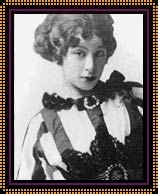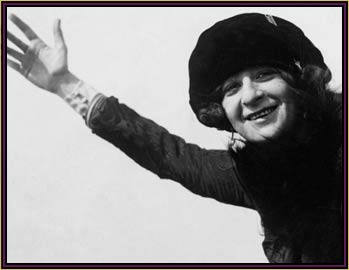Fanny Brice
- "Follies of 1910"
- "Follies of 1911"
- "Follies of 1919"
- "Follies of 1921"
- "The Honeymoon Express"
- "Nobody Home"
- "Ziegfeld Follies"
- Irving Berlin
- Eddie Cantor
- Bert Williams
- Florenz Ziegfeld
 In 1909, an 18-year-old comedienne named Fannie Borach came to Irving Berlin with a problem. Her career hadn’t been going so well — George M. Cohan had fired her from the chorus of one of his shows two years before, and she was reduced to performing from one burlesque hall to another. She needed a specialty number for a benefit performance the next night; she had lied to her producer about having one. Berlin took the girl to the back room of the Ted Snyder Music Publishing House and played her a tune he had, about a Jewish girl who improbably joins the stage to play one of history’s most famous vamps.
In 1909, an 18-year-old comedienne named Fannie Borach came to Irving Berlin with a problem. Her career hadn’t been going so well — George M. Cohan had fired her from the chorus of one of his shows two years before, and she was reduced to performing from one burlesque hall to another. She needed a specialty number for a benefit performance the next night; she had lied to her producer about having one. Berlin took the girl to the back room of the Ted Snyder Music Publishing House and played her a tune he had, about a Jewish girl who improbably joins the stage to play one of history’s most famous vamps.
Sadie Cohen left her happy home
To become an actress lady,
On the stage, she soon became the rage,
As the only real Salome baby.
It became Fanny Brice’s passkey to fame.
Brice grew up in far more comfortable surroundings than Berlin had, moving from her native Newark to Coney Island to Harlem, and from a young age, she was taken by her mother to every show they could catch. Quitting school to perform on the low-down burlesque circuits outside of Manhattan (burlesque being a form of satirical physical comedy, not the strip joints of later years), Brice did not specialize in any particular brand of comedy. When he played “Sadie Salome” for her, Berlin insisted a Yiddish accent was needed to put it over. Fannie had her reservations — she didn’t know any Yiddish — but it soon became her trademark dialect.
I breathed and ate and drank and lived theater — in my neighborhood were all the nationalities of all of Europe. That is where I learned my accents; the Polish woman with her intonation rising up like chant. I saw Loscha of the Coney Island popcorn counter and Marta of the cheeses at Brodsky’s Delicatessen and the Sadies and the Rachels and the Birdies at the Second Avenue dance halls. They all welded together and came out staggeringly true to type in one big authentic outline.
— Fanny Brice, 1936
When Fanny got a telegram to come down to see Florenz Ziegfeld a year later, she thought it was a joke. She had a friend, a secretary named Helen Ziegfeld, and every time they had a date for lunch, Fanny would say, “Ziegfeld wants to see me.” This time it was no joke. Impressed by his scouts’ reports of Brice’s success in local burlesque houses, Ziegfeld signed her for two years — at $75 a week, then $100. Fanny ran down the street with the signed contract, showing it to everyone on the corner of 47th and Broadway. It grew so tattered, Ziegfeld had to draft a new one. He didn’t mind; Ziegfeld never had much of sense of humor himself, but he knew his audience went for comics and, once again, he gave the public the best his money could buy.
Under her new stage name — Fanny Brice — she proved her comic versatility, slaying the audience in her “Follies” debut with another Yiddish number and even a blackface song — both by Irving Berlin. She always credited Ziegfeld with her success: “I’d rather work for him than any person in the world. If he’s the only person in the room, I can sing to him as if I had an audience of ten thousand!” Over the next two decades, she was a fixture in the “Follies,” appearing in seven different editions, and two more after the Shubert Brothers appropriated Ziegfeld’s name in the 1930s. She was at her best spoofing the grand pretensions of middle-class art — classical ballet, the Barrymore acting style, ragtime, and even herself. When her husband was convicted of gambling, her bad luck made it into the act. But Ziegfeld saw something else in Brice, beyond her goofy elasticity. On a trip to Paris, he bought the rights to a heartbreaking chanson called “Mon Homme” and had an English lyric made for his 1921 “Follies.” Fanny thought she would play it for comic effect, but Ziegfeld would have none of it.
Brice became the first crossover performer of the new century, eventually conquering not only Broadway but films, and most successfully radio, where she played the character of an aggressively precocious child, Baby Snooks, until she was well into her fifties. That Broadway and America would have adopted such an obvious ethnic type into their hearts is an immense tribute to Brice’s talent.
In anything Jewish I ever did, I wasn’t standing apart making fun. I was the race and what happened to me on stage is what could happen to my people. They identified with me, which made it all right to get a laugh. – Fanny Brice, 1936
In 1964, she would be immortalized in a lavish stage musical and film based on her complicated life, starring Barbra Streisand, but a fellow member of the “Follies,” chorus girl Dana O’Connell, understood the simplicity of her appeal: “Fanny Brice was just a delightful individual; we all got to know her quite well and we just loved her — the way she said things and moved with them, she was just funny. She was just a funny girl.”
Source: Excerpted from BROADWAY: THE AMERICAN MUSICAL by Michael Kantor and Laurence Maslon. Published by Bulfinch Press.
Photo credits: Photofest and the New York Public Library


